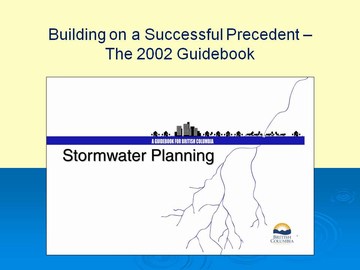Building the Green Economy: ‘Beyond the Guidebook 2010’ featured at BC Hydro Power Smart Forum on October 25
Note to Readers:
The rollout of Beyond the Guidebook 2010 commenced on September 27th at the 2010 annual convention of local governments. During the week of October 25, there will be presentations at three regional events, including the 2010 BC Hydro Power Smart Forum: Building the Green Economy. This leading conference is expected to attract about 1000 delegates.
Different members of the ‘convening for action’ partnership are rolling out Beyond the Guidebook 2010 at these regional events. The team of Kim Stephens, Ray Fung and Mike Tanner are delivering the presentation at the Power Smart Forum.
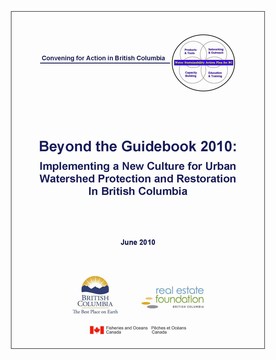
Preparing for Climate Change
In May 2010, the BC Hydro Power Smart team convened a select group of community leaders from across the province for a one-day dialogue.
Creating a Conservation Culture
“The intention is to learn with and from each other about what we can do to advance community based efforts in creating a conservation culture in BC,” stated Pia Nagpal (Program Manager for Community Engagement) in her opening remarks to the group.
 “BC Hydro Power Smart defines conservation quite broadly, to include more than just conserving energy or reducing greenhouse gas emissions. To achieve an environmentally-sustainable future with adequately functioning natural systems will require the involvement and commitment of all citizens.”
“BC Hydro Power Smart defines conservation quite broadly, to include more than just conserving energy or reducing greenhouse gas emissions. To achieve an environmentally-sustainable future with adequately functioning natural systems will require the involvement and commitment of all citizens.”
“At this year’s Power Smart Forum, we have incorporated a session about Beyond the Guidebook 2010 because it demonstrates what can be accomplished when one implements a culture change. Beyond the Guidebook 2010 is the story of doing business differently in the local government setting, and connecting with the community.”
Designing with Nature
Stormwater Planning: A Guidebook for British Columbia, released in June 2002, laid the groundwork for ‘designing with nature’ to create greener communities, live water smart and prepare for climate change.
Changing the way communities develop land depends on establishing higher expectations and challenging practitioners to embrace shared responsibility. A decade ago, the Province made a conscious decision to follow an educational rather than prescriptive path.
British Columbia is at a tipping point. Implementation of a new culture for urban watershed protection and restoration is within our grasp. Beyond the Guidebook 2010 explains why, and illustrates how breakthroughs happen when decision-makers in government collaborate with grass-roots visionaries in the community.
To Learn More:
To download a copy of this provincial guidance document, click on Beyond the Guidebook 2010: Implementing a New Culture for Urban Watershed Protection and Restoration in British Columbia

Convening for Action in British Columbia
Kim Stephens, Ray Fung and Mike Tanner will be elaborating on elements of the “convening for action story” in an integrated presentation. They will introduce the context for changing water management practices at the site level, explain the BC process for moving from awareness to action, and describe how the Water Bucket website is the key to the communication strategy.
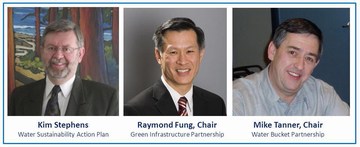
Nature of the Paradigm-Shift
“In 2002, the Guidebook advanced this provocative premise: land development and watershed protection can be compatible. At the time, this was considered to be radical thinking,” states Kim Stephens, Program Coordinator for the Water Sustainability Action Plan for British Columbia.
“The paradigm-shift resulted from recognition of HOW a science-based understanding could bridge the gap between high-level policy goals and site design practices. Over the past decade we have been developing the tools and experience to build and/or rebuild communities in balance with ecology.”
“Changing the practitioner culture takes time to complete. There is no short-cut. The case study experience documented in Beyond the Guidebook 2010 will help those who want to implement change.”
To Learn More:
The formal rollout of Beyond the Guidebook 2010 commenced at the UBCM Annual Convention. Click on Forging Gold Medal Standards for Urban Watershed Protection and Restoration in British Columbia to read all about it.
 Glen Brown and Ray Fung represented the provincial and local government perspectives, respectively, in delivering an integrated presentation to a packed study session (180 attendees).
Glen Brown and Ray Fung represented the provincial and local government perspectives, respectively, in delivering an integrated presentation to a packed study session (180 attendees).
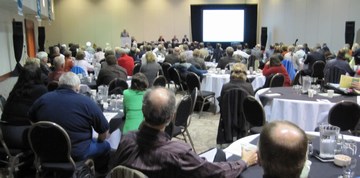
Embracing Shared Responsibility Leads to Outcome-Oriented Actions
“Shared responsibility is a foundation piece for Beyond the Guidebook 2010. Furthermore, the case study experience presented in Beyond the Guidebook 2010 shows that a new land ethic is taking root in BC,” continues Ray Fung, Director of Engineering and Transportation with the District of West Vancouver, and Chair of the Green Infrastructure Partnership.
“Beyond the Guidebook 2010 synthesized a set of ten guiding principles that provide a framework for a successful local government implementation process. Two of these are particularly important: choose to be enabled; and promote shared responsibility.”
“So, what we mean by shared responsibility is that everyone has a role, and everyone can act…. all levels of government, developers, regulators, bureaucrats, consultants, planners, engineers…. we all have a role.”
Link to YouTube Video:
To view a 90-second video clip of Ray Fung speaking about Shared Responsibility at the UBCM Annual Convention, click here.
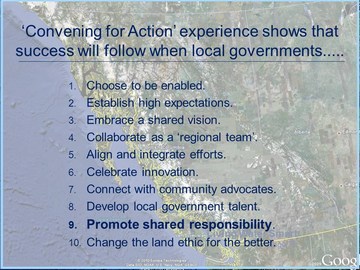
Twin Engines for Outreach & Continuing Education Program: Water Bucket & Water Balance Model
“Beyond the Guidebook 2010 devotes a chapter to describe the Outreach & Continuing Education Program, known by the acronym OCEP, that we have developed to promote a ‘water-centric’ approach to community planning and development,” states Mike Tanner, Chair of the Water Bucket Website Partnership.
“OCEP comprises inter-connected elements that give local governments and practitioners the tools and experience to better manage land and water resources. Two tools in the toolbox are the Water Balance Model and the Water Bucket Website. They are the twin engines driving OCEP.”
“The Water Bucket website comprises a family of ‘communities-of-interest’, or COIs, that provide a ready-made platform for advancing a ‘design with nature’ approach to community development. These COIs provide local governments with a sustainability lens through which they can view their plans and planning activities.”
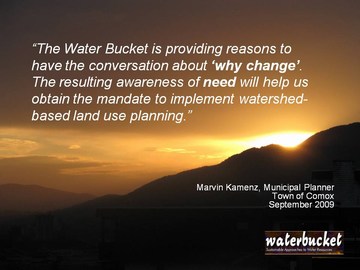
Stormwater Planning: A Guidebook for British Columbia
In October 1997, a focus group workshop convened by the Union of British Columbia Municipalities set in motion a chain of actions that culminated in the Province producing Stormwater Planning: A Guidebook for British Columbia. Released in June 2002, the Guidebook quickly became a catalyst for action to implement a ‘design with nature’ approach to rainwater management and green infrastructure.
The Guidebook applied a science-based understanding, developed the water balance methodology to establish performance targets for rainfall capture, and demonstrated that urban watershed restoration could be accomplished over a 50-year timeframe as and when communities redevelop.
Beyond the Guidebook
By 2007, it was time to focus attention on how to truly protect and/or restore stream health in urban watersheds. Beyond the Guidebook 2007 initiated the paradigm-shift from the single-function view of traditional ‘stormwater management’ to the integrated and holistic perspective that is captured by the term ‘RAINwater Management’.
Building on case study experience, Beyond the Guidebook 2010 provides local governments with ‘how to’ guidance for developing outcome-oriented urban watershed plans. The foundation for ‘RAINwater management’ is the ‘runoff-based’ approach to establishing targets for rainfall capture at a watershed scale.
Keyed to the estimation of the amount of water in the stream over a long period of time, the ‘runoff-based’ approach connects these dots: impacts to a stream; the causes in the urban landscape; and the mitigation methods needed to restore the natural water balance in the stream. RAINwater management is about protecting streams, not how much volume one can infiltrate on sites.
To Learn More:
Click on Beyond the Guidebook 2010 Advances Runoff-Based Approach to Setting Watershed Performance Targets — A framework for developing integrated and holistic plans is consolidated in a single table. This ‘mind-map’ lays out the cascading logic for establishing, evaluating and implementing watershed-specific runoff targets that will protect stream health.